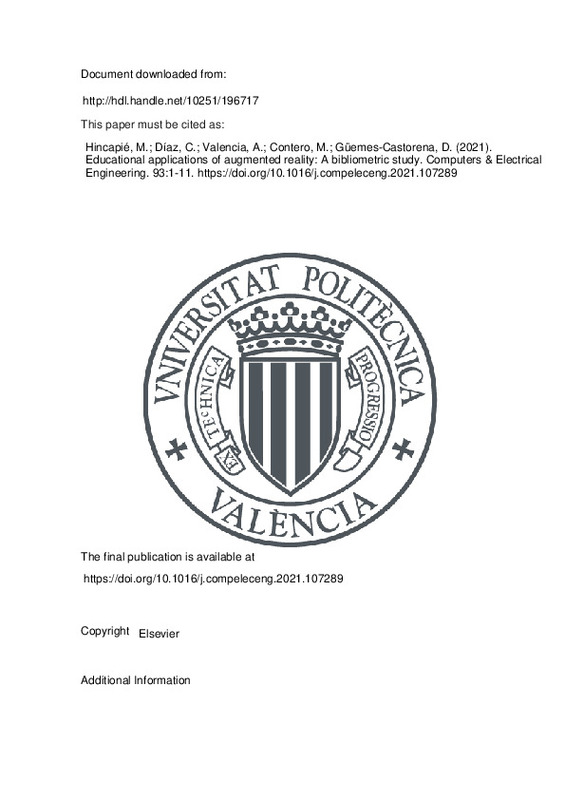JavaScript is disabled for your browser. Some features of this site may not work without it.
Buscar en RiuNet
Listar
Mi cuenta
Estadísticas
Ayuda RiuNet
Admin. UPV
Educational applications of augmented reality: A bibliometric study
Mostrar el registro sencillo del ítem
Ficheros en el ítem
| dc.contributor.author | Hincapié, Mauricio
|
es_ES |
| dc.contributor.author | Díaz, Christian
|
es_ES |
| dc.contributor.author | Valencia, Alejandro
|
es_ES |
| dc.contributor.author | Contero, Manuel
|
es_ES |
| dc.contributor.author | Güemes-Castorena, David
|
es_ES |
| dc.date.accessioned | 2023-09-18T18:02:08Z | |
| dc.date.available | 2023-09-18T18:02:08Z | |
| dc.date.issued | 2021-07 | es_ES |
| dc.identifier.issn | 0045-7906 | es_ES |
| dc.identifier.uri | http://hdl.handle.net/10251/196717 | |
| dc.description.abstract | [EN] Augmented Reality (AR) has been used successfully in several industries; one of these is education. A systematic understanding of how AR contributes to education still lacks studies about the content type and its effects on learning outcomes. This article systematically analyzes the AR state-of-the-art in education, determines productivity and publication indicators in this field, and identifies research works that have studied how content type affects the learning outcomes. The methodology was performed through a bibliometric analysis using the Scopus database, focusing on AR's educational uses. Engineering education is the primary research trend, followed by simulation, tracking, and virtual reality. Education and e-learning also have leading roles within this analysis, along with gamification and human-computer interaction, whose impacts are further explored. There is no preferred design methodology for creating AR content. In its absence, most of the works suggest a design based on the developers' and researchers' experience. | es_ES |
| dc.description.sponsorship | The authors thank the editors and two anonymous reviewers for their highly constructive feedback. The authors also would like to acknowledge the technical support of Writing Lab, Institute for the Future of Education, Tecnologico de Monterrey, Mexico, in the production of this work | es_ES |
| dc.language | Inglés | es_ES |
| dc.publisher | Elsevier | es_ES |
| dc.relation.ispartof | Computers & Electrical Engineering | es_ES |
| dc.rights | Reconocimiento - No comercial - Sin obra derivada (by-nc-nd) | es_ES |
| dc.subject | Augmented reality | es_ES |
| dc.subject | Educational innovation | es_ES |
| dc.subject | Educational technology | es_ES |
| dc.subject | Human-computer interaction | es_ES |
| dc.subject | Simulation, higher education | es_ES |
| dc.subject.classification | EXPRESION GRAFICA EN LA INGENIERIA | es_ES |
| dc.title | Educational applications of augmented reality: A bibliometric study | es_ES |
| dc.type | Artículo | es_ES |
| dc.identifier.doi | 10.1016/j.compeleceng.2021.107289 | es_ES |
| dc.rights.accessRights | Abierto | es_ES |
| dc.contributor.affiliation | Universitat Politècnica de València. Escuela Técnica Superior de Ingenieros Industriales - Escola Tècnica Superior d'Enginyers Industrials | es_ES |
| dc.description.bibliographicCitation | Hincapié, M.; Díaz, C.; Valencia, A.; Contero, M.; Güemes-Castorena, D. (2021). Educational applications of augmented reality: A bibliometric study. Computers & Electrical Engineering. 93:1-11. https://doi.org/10.1016/j.compeleceng.2021.107289 | es_ES |
| dc.description.accrualMethod | S | es_ES |
| dc.relation.publisherversion | https://doi.org/10.1016/j.compeleceng.2021.107289 | es_ES |
| dc.description.upvformatpinicio | 1 | es_ES |
| dc.description.upvformatpfin | 11 | es_ES |
| dc.type.version | info:eu-repo/semantics/publishedVersion | es_ES |
| dc.description.volume | 93 | es_ES |
| dc.relation.pasarela | S\456770 | es_ES |







![[Cerrado]](/themes/UPV/images/candado.png)

